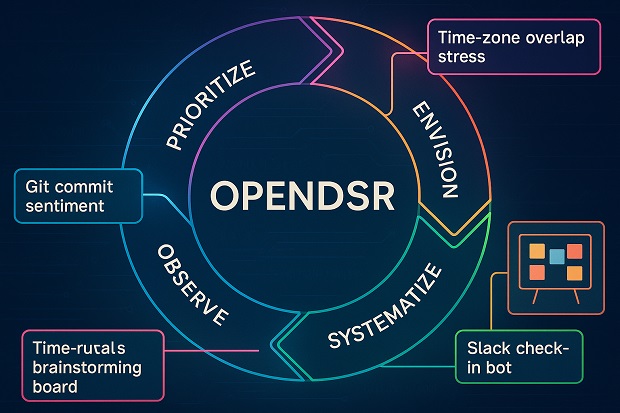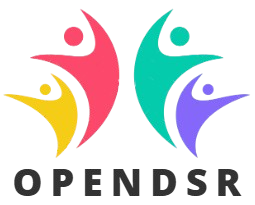
OPENDSR for IT & Tech: Driving Engagement in Remote Teams
Step 1: Observe 👀 – Listening Beyond Metrics
Most IT leaders already collect performance data — velocity, uptime, bugs.
But those are system metrics, not experience signals.
OPENDSR’s Observe step teaches teams to tune into human telemetry.
For example:
- Use chat analysis to detect tone drift (e.g., rising negativity).
- Read retrospectives not just for outcomes, but for emotion words.
- Encourage micro feedback loops after stand-ups or code reviews.
A real-world example:
A distributed DevOps team noticed increasing “review lag.” Instead of punishing throughput, they used OPENDSR’s Observe Lens to discover the cause — junior developers felt intimidated commenting on senior engineers’ work.
The fix? Mentorship pairing and “safe review slots.” Productivity rebounded — not because of pressure, but because of empathy.
Step 2: Prioritize – Finding the Friction that Matters
IT leaders face hundreds of signals.
OPENDSR brings focus through Friction Prioritization Maps — a structured way to rank issues by:
- Frequency
- Impact on experience
- Ease of resolution
For instance, an enterprise IT helpdesk discovered:
- Most burnout was linked not to volume, but to lack of closure loops (“tickets closed, but people not thanked”).
- By prioritizing recognition rather than workload redistribution, morale lifted 20% in one quarter.
“You can’t fix everything — but you can fix the moments that matter.”
– OPENDSR Principle
Step 3: Envision – Designing Human-Centered Tech Rituals
Tech teams love frameworks — Agile, Scrum, DevOps.
But none of them start with how people feel.
OPENDSR’s Envision step introduces Empathy-led Design Thinking.
Teams co-create rituals like:
- Virtual Demo Fridays — quick, fun showcases of personal or project work.
- Focus Hours — no-meeting blocks synchronized across zones.
- “Coffee Bots” that auto-pair colleagues weekly for informal chats.
The idea isn’t to add fluff — it’s to design emotional safety into digital spaces.
When engineers co-design their own engagement rituals, adoption skyrockets — because they helped build the blueprint.
Step 4: Navigate – Turning Ideas into Action
OPENDSR’s Navigate step helps translate vision into practice.
It uses simple Experience Roadmaps that map what, who, and when across three dimensions:
- People: Engineers, managers, HR, leadership.
- Moments: Onboarding, sprint cycles, retrospectives.
- Systems: Tools like Teams, JIRA, Confluence, GitHub.
Example:
A global product team mapped its “onboarding experience” and discovered that remote hires waited 5 days before their first real code commit.
By navigating this with OPENDSR, they redesigned onboarding checklists and reduced time-to-contribution by 60%.
Step 5: Design – Embedding Standards in Workflows
Once ideas take shape, Design Standards turn them into repeatable patterns.
In IT organizations, OPENDSR introduces templates for:
- Inclusive Meeting Design → every stand-up includes async input.
- Recognition Tokens → simple, public appreciation through bots.
- Feedback Frameworks → feedback shared weekly, not yearly.
- Team Health Dashboards → one-click pulse scores integrated into dev tools.
Design Standards help remote teams normalize empathy — just like they standardize code reviews or security checks.
Empathy, when systematized, becomes culture.
Step 6: Systematize – Automating Engagement
Automation isn’t the enemy of empathy — it’s its amplifier.
Systematize means building engagement into the system layer:
- Slack bot triggers weekly check-ins (“How’s your energy this week?”).
- SharePoint or Teams dashboards auto-surface friction insights.
- HRIS integrations trigger recognition for project milestones.
A real case:
A European SaaS firm used Microsoft Teams + OPENDSR System Hooks to automate recognition for successful sprint completions.
Within 8 weeks:
- Peer-to-peer shout-outs increased by 46%.
- Burnout mentions in retros dropped by 31%.
Automation turned empathy into habit.
Step 7: Refine – Continuous Learning, Continuous Care
The final step closes the loop.
Refine keeps the system alive by using real-time intelligence to track what’s working.
IT teams create Refinement Journals or EX Sprints, where:
- Every quarter, they review what improved (e.g., morale, collaboration).
- They log what didn’t work (e.g., over-automation, fatigue).
- They adjust designs, rituals, and systems accordingly.
A simple quarterly rhythm transforms engagement from an HR event into a product mindset — iterative, agile, human.
Real-World Example: The Distributed DevOps Team
A 1,200-person IT services firm across India, Germany, and the US implemented OPENDSR in its engineering division.
Problem:
Despite strong output, engagement scores fell 18%. Anonymous comments cited “loneliness,” “invisible effort,” and “no clear recognition.”
Solution:
Using OPENDSR’s 7-step cycle:
- Observe: Slack and retrospective analysis showed social isolation themes.
- Prioritize: Identified 3 main friction points — visibility, recognition, connection.
- Envision: Teams co-created weekly “Code & Coffee” async hangouts.
- Navigate: Mapped quick actions across tools (Slack + Confluence).
- Design: Built recognition templates linked to JIRA completions.
- Systematize: Automated recognition pings via Teams webhook.
- Refine: Measured sentiment every sprint using simple pulse surveys.
Results after 3 months:
- 27% increase in perceived connection.
- 35% increase in recognition interactions.
- 12% drop in attrition intent among senior engineers.
- And most importantly — a sense of belonging restored.
Voices from the Field
“OPENDSR helped us stop treating engagement as an HR thing. It’s now a DevOps thing — continuous, iterative, owned by everyone.”
— Engineering Director, CloudOps
“The framework gave structure to something we all felt but couldn’t articulate — how our people feel working remotely.”
— Product Owner, Enterprise SaaS
“Now, retros aren’t just about bugs and features — they’re about friction and flow.”
— Scrum Master, FinTech Startup
Tangible Benefits of OPENDSR for IT & Tech
Impact Area
Outcome
Example
Engagement
+25–40% sustained over 6 months
Team pulse sentiment tracking
Retention
–15% attrition in remote units
Predictable workload & recognition
Productivity
+12% task throughput
Fewer blockers from communication gaps
Wellbeing
+18% reported mental energy
Inclusion of async rest rituals
Culture Trust
3× faster recovery from friction
Regular refinement cycles
OPENDSR doesn’t just make employees happier — it optimizes performance through empathy.
Integration with Digital Workplaces
For IT organizations already using platforms like Microsoft Teams, SharePoint, Slack, or JIRA, OPENDSR integrates seamlessly:
- Teams + Power Automate: automate nudges and recognition flows.
- SharePoint + Viva: host experience dashboards and journals.
- Slack APIs: trigger engagement bots.
- JIRA / GitLab Hooks: feed real-time sentiment into dashboards.
This is how CorporateOne, the SharePoint-based EX platform built on OPENDSR principles, enables IT enterprises to run experience operating systems directly inside their intranet — not as another layer, but as the DNA of work.
From Remote to Resilient: The Future of IT Workplaces
The remote revolution in tech isn’t slowing down — it’s maturing.
But engagement, not connectivity, will define its future.
OPENDSR helps IT leaders evolve from:
- Managing people → Designing experiences.
- Tracking metrics → Interpreting signals.
- One-time fixes → Continuous refinement.
When empathy becomes operational, culture scales as fast as code.
Conclusion: Engagement is the New Infrastructure
In the IT world, we spend billions on infrastructure for systems — networks, servers, and pipelines.
But the real infrastructure of performance is engagement.
OPENDSR transforms engagement from a soft metric into a strategic system:
- Observing signals in real time.
- Designing inclusive digital practices.
- Systematizing empathy into every workflow.
- Refining continuously through data and dialogue.
For IT & Tech organizations navigating a remote world, OPENDSR isn’t just a framework —
it’s the new architecture of connection.








